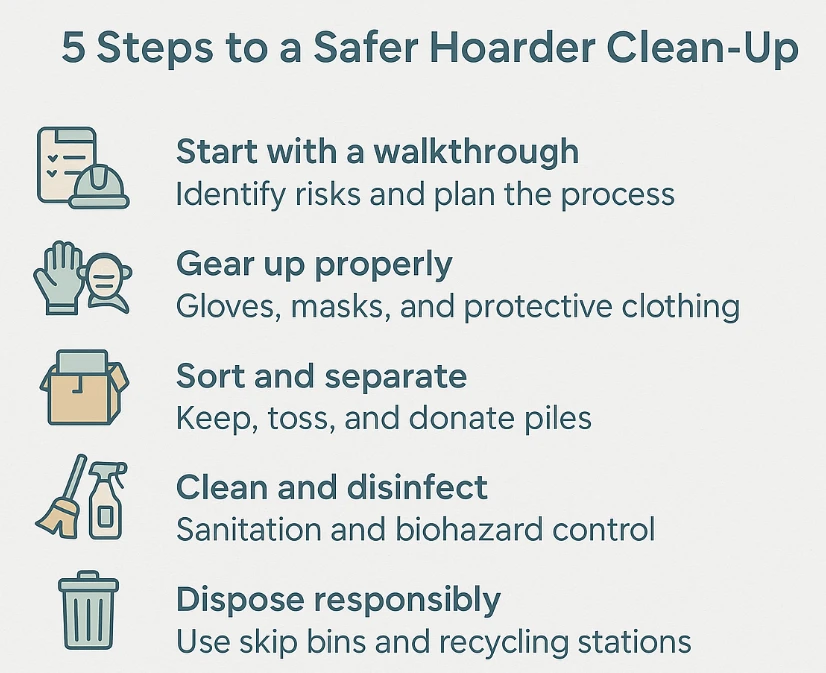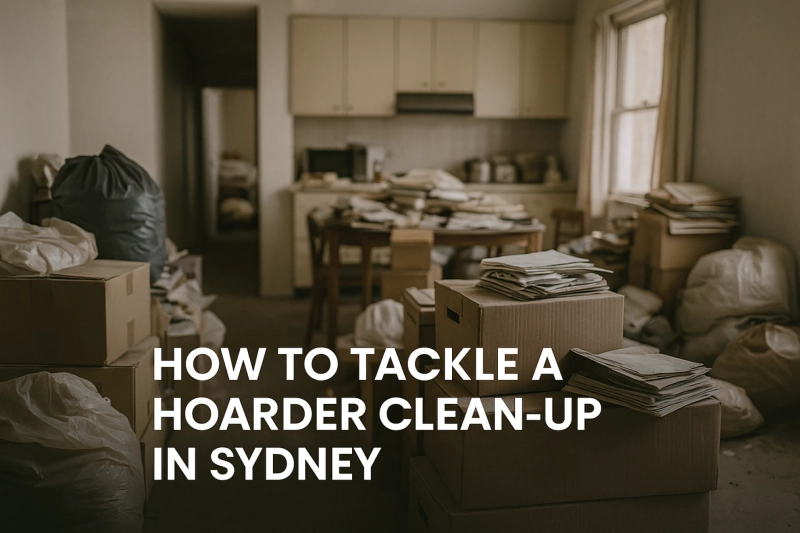Trying to clean a hoarded space can feel completely overwhelming. It's not just about getting rid of clutter—it often involves health risks, emotional strain, and decisions that aren’t always black and white. In Sydney, where living spaces are often compact and neighbours live close by, hoarding can quickly turn into a serious issue for everyone involved.
If you're facing this for the first time—whether in your own home or someone else's—you might be wondering how to even begin. One thing’s clear: jumping in without a plan rarely ends well. Especially when dealing with deep-set clutter or hidden health hazards, calling in a professional hoarder clean-up crew can take a lot of the pressure off.
Why hoarding is more than just a mess
It's easy to confuse hoarding with just being messy or disorganised. But true hoarding is often connected to anxiety or trauma. It’s not about laziness—it’s about not being able to let go, even when the situation becomes unsafe.
You might notice things like:
- Piles of newspapers, broken furniture, or packaging stacked in walkways
- Kitchen and bathroom areas are becoming unusable
- Food is going off and attracting pests
- Items blocking exits or creating fire risks
- A reluctance to let anyone enter the home
These aren’t just inconvenience-level problems. They can become serious hazards over time.
When it's time to ask for help
Most people don’t realise how bad things have gotten until a crisis forces them to act. That might be a health scare, a fall, a fire risk notice, or just a concerned neighbour speaking up.
Signs that it’s time to get outside help:
- There's mould, animal waste, or strong odours
- You can’t safely access parts of the home
- Appliances, toilets, or sinks no longer function
- The resident is overwhelmed or distressed by the idea of clearing things out
- Structural damage or infestation is present
Getting help doesn’t mean giving up control—it means making space for health and safety to come first.
What the clean-up process looks like
Professional hoarder clean-up services aren’t there to judge. They show up with gloves, masks, and a plan. Most start with a conversation. They’ll ask questions to understand what matters, what needs to stay, and what needs to go.
Here’s what the process often includes:
- Walking through the space and assessing risks
- Grouping items into categories—keep, donate, toss
- Safe disposal of perishables, sharp objects, and broken items
- Sanitising and deep cleaning affected areas
- Removing bulky waste and recyclables
- Respecting emotional boundaries and handling sensitive items with care
In some cases, this happens in one long session. In others, it’s a slow and steady approach over several visits.
A personal story: When my aunt needed help
A few years ago, my aunt had a fall in her hallway. Paramedics had trouble getting in because of all the boxes. She always said she’d get around to tidying up, but it had reached a point where the place just wasn’t safe anymore.
We brought in a local team, and they were incredible. No pressure, no judgment—just patient, careful work. They even found an old family photo album buried under years of unopened mail. That clean-up wasn’t just about space—it gave her back some peace of mind.
Legal and health rules in Sydney
In Sydney, serious hoarding cases can draw attention from councils, building managers, or even emergency services. That’s not meant to shame anyone, but once safety is at stake, action has to be taken.
Authorities often refer to resources like hoarding and environmental neglect support. These guidelines help families and support workers make safe, respectful decisions without stepping on legal landmines.
If you think neighbours might be affected or if you're in a rental, it’s worth checking what rules apply to your area.
The emotional weight of letting go
Most people underestimate how hard it is to part with things, even when they’re broken or useless. For someone who’s been hoarding, those objects might feel like anchors. Even just the idea of someone else touching their things can be deeply distressing.
It’s important to approach things gently. If possible, have the resident involved in the process. If that’s not realistic, make sure someone they trust is in the loop. Emotional support is just as vital as cleaning supplies.
There are helpful articles for navigating hoarding clean-up support that dig deeper into this side of things—worth a read if you’re walking this road with a loved one.
How to prep before a crew arrives
You don’t need to deep clean beforehand—that’s what the professionals are there for. But there are a few small steps that can smooth the path forward:
- Make sure there’s clear access to the property
- Set aside any vital documents or medications
- Let the resident know who’s coming and when
- Share any health concerns or known hazards with the team
- Arrange a break space or plan somewhere to decompress if it gets intense
The more information the team has up front, the safer and more respectful they can be.
What happens after everything's cleared?
The end of a clean-up isn’t the end of the story. In many cases, it's just the beginning of something better. A fresh space makes it easier to cook, move around, and even sleep better.
But it’s also common for old habits to creep back. That’s why many services offer check-ins or follow-up sessions. You might also look into systems and tools that help with organisation and regular waste disposal.
If you’re supporting someone else, it helps to share decluttering tips for the severe mess to keep momentum going.
Why professionals are worth every cent
It’s tempting to think you can manage it yourself, but deep hoarder clean-ups involve more than time and energy. There are safety risks, emotional landmines, and physical hazards that aren’t always obvious until you’re knee-deep.
Professionals:
- Bring protective gear and know how to spot risks
- Handle biohazards and heavy lifting
- Sort items respectfully and quickly
- Understand when to step back and when to dig in
- Know how to work with council guidelines and health rules
In the long run, they save time, reduce conflict, and protect your physical and mental well-being.
Looking ahead with empathy
Clearing a hoarded space is never just about the physical mess. It’s about rebuilding safety, comfort, and peace of mind. It’s about understanding that every item might carry a story, even if it looks like junk to you.
In Sydney, there are plenty of professionals who understand how complex this work really is. They won’t rush or judge. They’ll meet people where they are and help them move forward, one bag at a time.
If you’re facing a tough clean-up—at home or for someone you love—know that help exists. And it works.


